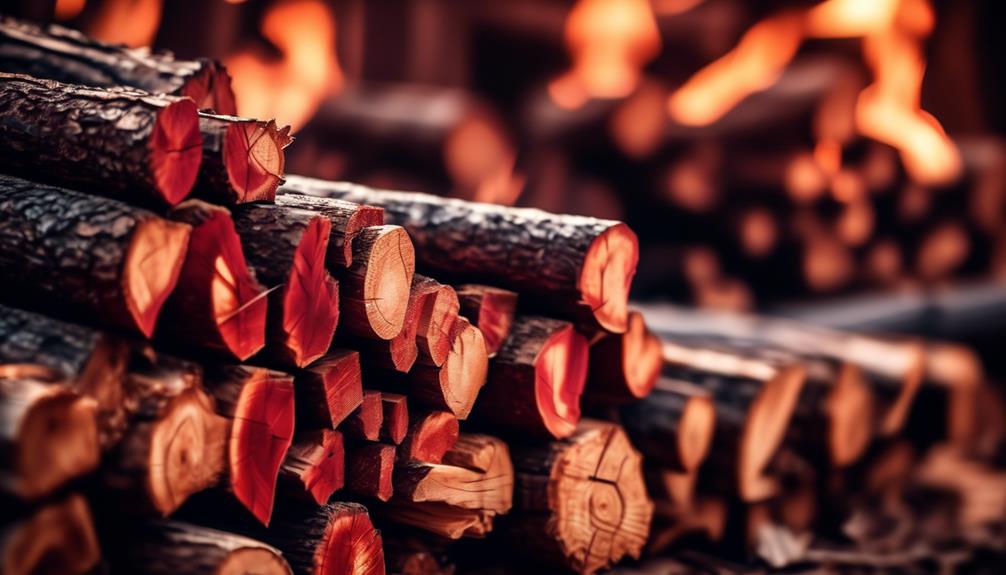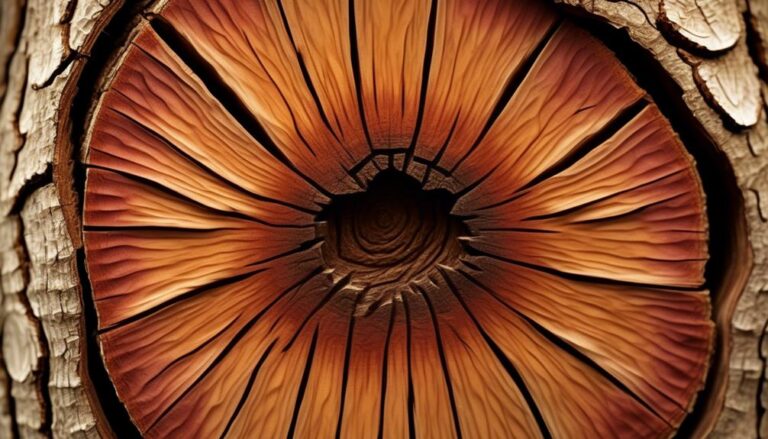Is Sweet Gum Good Firewood
You may have come across some sweet gum logs while clearing your backyard or perhaps a neighbor offered you a stack of them. Now, you're wondering if sweet gum is good firewood.
Well, the answer isn't as straightforward as you might hope. Sweet gum has its pros and cons when it comes to burning. In this discussion, we'll explore the burning characteristics, moisture content, heat output, and even compare sweet gum to other firewood types.
So, let's get started and find out if sweet gum is worth your time and effort as firewood.
Sweet Gum Firewood Pros and Cons
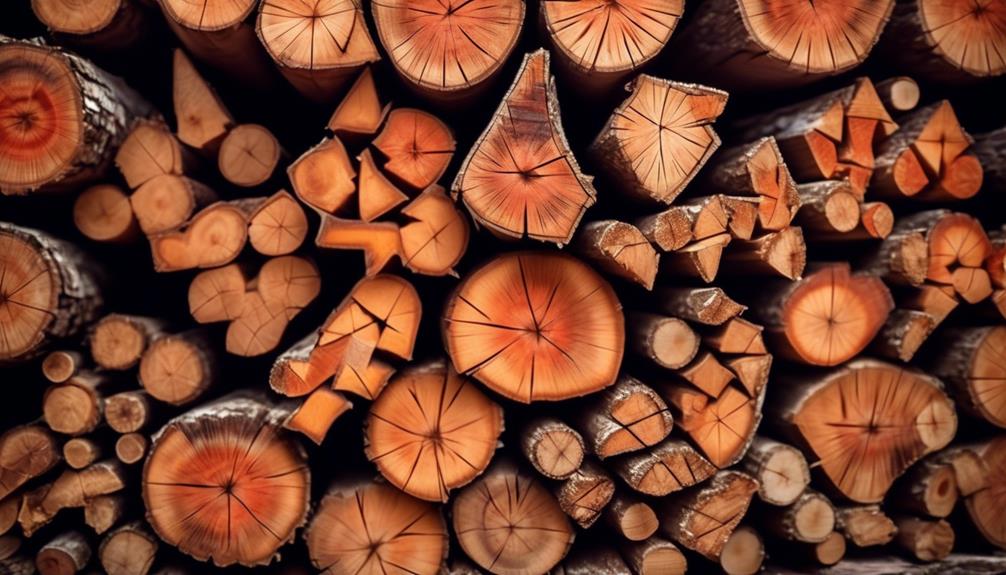
Sweet Gum firewood has both advantages and disadvantages when it comes to using it as a source of heat.
One of the pros is that it produces a decent amount of heat, approximately 20.6 million BTUs per cord.
However, there are several cons to consider as well. Sweet gum wood is challenging to split, stack, and handle due to its interlocking grain and high resin/sap content. It also burns quickly and lacks good coaling qualities. Moreover, burning sweet gum may result in a lot of smoke and an unpleasant odor.
Properly drying sweet gum takes up to a year, and it's crucial to store it under a roof or cover to prevent rot and mold.
To improve its overall performance, consider mixing sweet gum with other hardwoods.
Burning Characteristics of Sweet Gum
When burning sweet gum as firewood, it's important to consider its unique burning characteristics.
Sweet gum is known for its high heat output, making it an excellent choice for warming up your home during the colder months. It burns hot and long, providing a steady source of heat.
However, it does produce a fair amount of smoke and sparks, so it's important to use caution and have proper ventilation when burning sweet gum.
Additionally, sweet gum can be difficult to split and may require more effort to prepare for burning compared to other types of firewood.
Despite these considerations, if you're willing to put in the extra effort, sweet gum can be a good choice for firewood due to its high heat output and long burning time.
Moisture Content and Drying Time
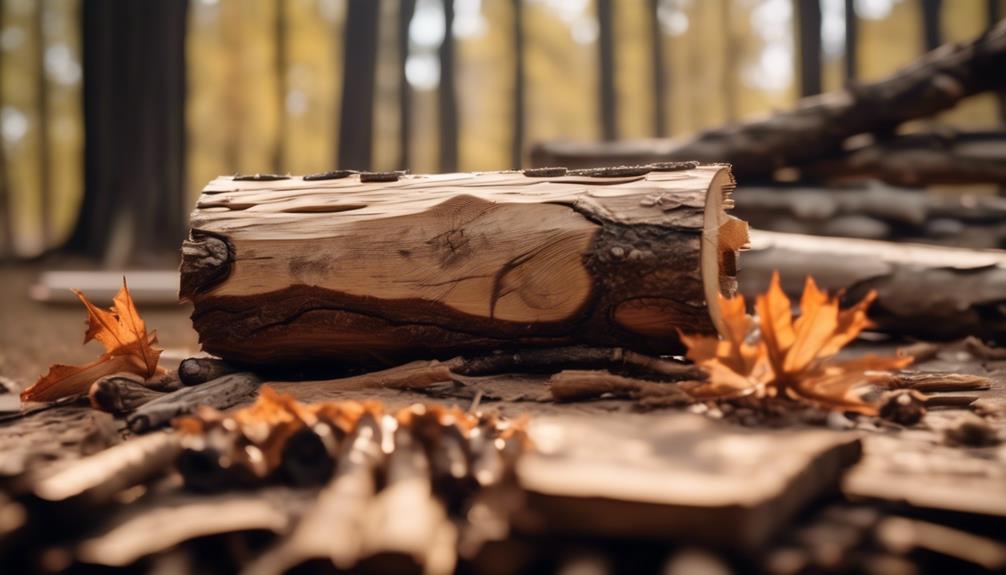
To ensure efficient drying of sweet gum wood, it's crucial to achieve the optimal moisture content of around 12 percent. This process can take up to a year due to the wood's interlocking grain, which increases drying time and can lead to warping.
To accelerate the drying time, store the wood under a roof or cover to prevent rot and mold while allowing air circulation.
Drying Sweet Gum Efficiently
Efficiently drying sweet gum involves ensuring the moisture content is properly regulated and the drying time is optimized.
Sweet gum firewood can be a good option for heating and cooking, but it needs to be dried efficiently before use. The moisture content of sweet gum should ideally be between 15% and 20% for optimal burning.
To achieve this, it's recommended to split the wood into smaller pieces and store it in a well-ventilated area. This allows for better air circulation and faster evaporation of moisture.
Drying time can vary depending on the initial moisture content, but it typically takes about 6 to 12 months to fully dry sweet gum firewood. It's important to regularly check the moisture content using a moisture meter to ensure it's ready for use.
Moisture Content Requirements
Proper moisture content is crucial for effectively drying sweet gum firewood. Sweet gum is known to be difficult to dry, especially for furniture, as it can take up to a year to season the wood. The interlocking grain of sweet gum increases drying time and can lead to warping.
To prevent rot and mold, it's recommended to store the wood under a roof or cover.
When it comes to burning sweet gum, the optimal moisture content is around 12 percent. Sweet gum wood burns hot, generating 20.6 million BTUs per cord.
However, splitting sweet gum wood can be challenging due to warping and interwoven fibers. It's best to split the wood when it's greener, before it dries and warps.
For longer burning time, consider mixing sweet gum wood with other hardwoods like hickory and oak, as sweet gum has a high resin content.
Accelerating Drying Time
Drying sweet gum firewood can be a time-consuming process, but there are ways to accelerate the drying time and reduce the risk of warping. Due to its high resin content and interlocking grain, sweet gumwood takes up to a year to season properly.
To prevent rot and mold, it's essential to store the firewood under a roof or cover. To speed up the drying process, it's recommended to split the wood when it's greener, before it dries and warps. Additionally, mixing sweet gumwood with other woods like hickory and oak can increase burning time and help accelerate the drying time.
It's important to note that the optimal moisture content for burning sweet gumwood is around 12 percent. Sweet gumwood burns hot, providing 20.6 million BTUs per cord.
Heat Output and Energy Efficiency
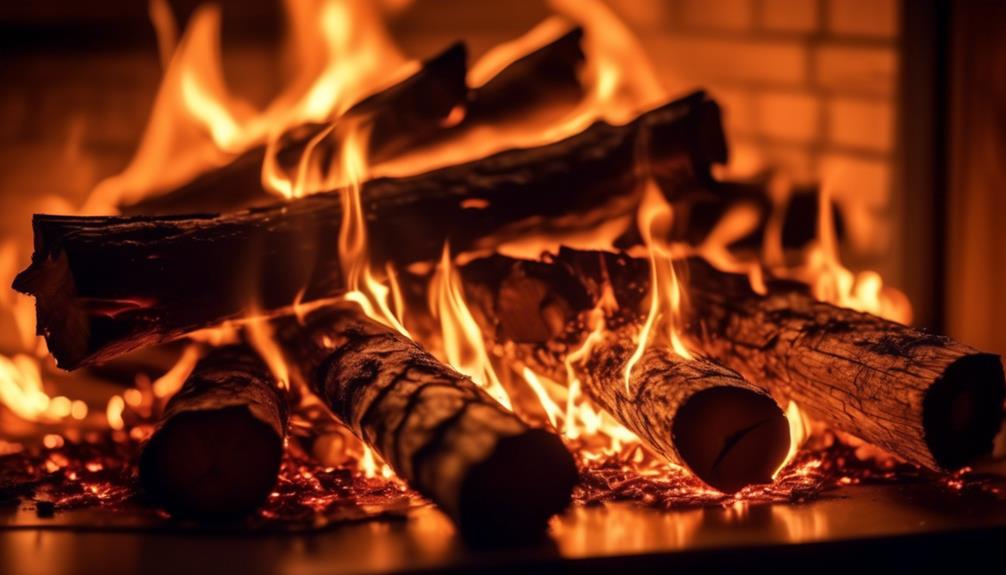
Sweet gum firewood, with its high heat output and energy efficiency, is an excellent choice for heating your home. Here are some important facts to consider:
- Sweet gum firewood produces approximately 20.6 million BTUs per cord, making it a high heat output wood.
- Its high resin content makes it easy to start a fire, contributing to its energy efficiency.
- When seasoned properly, sweet gum wood burns hot and for a long time, making it an efficient choice for heating.
- Mixing sweet gum wood with other hardwoods like hickory and oak can increase its burning time and overall energy efficiency.
- Properly drying out sweet gum wood is crucial for energy efficiency, as it can be difficult to ignite and may produce a lot of smoke and sparks if used when not seasoned.
With its impressive heat output and energy efficiency, sweet gum firewood is a reliable option for keeping your home warm.
Comparing Sweet Gum to Other Firewood Types
When comparing sweet gum to other firewood types, there are a few key points to consider.
Firstly, sweet gum has a high heat output, producing approximately 20.6 million BTUs per cord.
However, it burns quickly and lacks good coaling qualities.
Despite these drawbacks, it can still be used as a heat source when mixed with other hardwoods or if it's readily available.
Burning Sweet Gum
While not a popular choice for firewood, sweet gum can still be used for burning, although it requires extra effort to split and stack. If you're considering burning sweet gum, here are a few things you should know:
- Sweet gum firewood produces approximately 20.6 million BTUs per cord, providing a decent amount of heat.
- Splitting sweet gum can be challenging, but using a hydraulic splitter is the best way to tackle it. If you don't have one, a sharp splitting axe can be used to shave off thin chunks from the edges.
- When burned, sweet gum firewood doesn't have good coaling qualities and burns quickly. It also produces a lot of smoke, similar to pine firewood but without the sticky sap.
While sweet gum can be burned, it's often mixed with other hardwoods for better burning results. Consider these factors before using sweet gum as firewood.
Heat Output Comparison
Comparing the heat output of sweet gum firewood to other types can help you determine its effectiveness as a heat source. Sweet gum produces approximately 20.6 million BTUs per cord, which makes it a decent option for heating.
However, it's important to note that sweet gum firewood burns quickly and lacks good coaling qualities. This means that it may not provide long-lasting heat and might need to be replenished more frequently.
To enhance its burning qualities and overnight burning performance, you can mix sweet gum with other hardwoods.
Keep in mind that sweet gum is difficult to split and stack, which can increase the processing time. Therefore, if you require a large amount of firewood, it's recommended to avoid sweet gum.
Wood Burning Efficiency
Sweet gum firewood, despite its difficulty to split and stack, can still be used for heating if free sweet gum wood is available. When it comes to wood burning efficiency, sweet gum has some drawbacks compared to other firewood types. Here are a few key points to consider:
- Sweet gum firewood burns quickly, which means it may not provide a long-lasting heat source.
- It doesn't have good coaling qualities, meaning it may not produce a long-lasting bed of hot coals.
- Sweet gum firewood may produce a lot of smoke with an unpleasant odor, which can be a nuisance.
While sweet gum can be used for heating, it may not be the most efficient option. If possible, consider mixing sweet gum with other hardwoods to improve its burning qualities. Additionally, sweet gum firewood is more suitable for use during mild outside temperatures.
Splitting and Storing Sweet Gum Firewood
To efficiently split sweet gum firewood, it's recommended to use a hydraulic wood splitter. Sweet gum's interlocking grain and twisting fibers can make it challenging to split using other methods. A hydraulic wood splitter provides the necessary force to easily split the wood into manageable pieces.
Once the sweet gum firewood is split, it's important to store it properly. Storing sweet gum firewood under a roof or cover is essential to protect it from moisture, which can cause rot and mold.
Sweet gum firewood burns quickly and produces a lot of smoke, so it's best to mix it with other hardwoods for better burning results and increased heat output.
Smoke and Odor: What to Expect

When burning sweet gum firewood, you can expect a significant amount of smoke to be produced. Here's what you need to know about the smoke and odor that comes with burning sweet gum firewood:
- Sweet gum firewood may have an unpleasant odor when burned, which can be described as a mix of resinous and musty.
- The smoke produced by burning sweet gum firewood can be thick and can sometimes have an acrid smell.
- The sticky sap in sweet gum wood can contribute to the smoke and odor, as it tends to burn slowly and release more smoke.
To minimize the smoke and odor, it's recommended to mix sweet gum with other hardwoods that have better burning qualities.
- Keep in mind that sweet gum firewood burns quickly and doesn't produce good coaling qualities.
- To improve the burning performance of sweet gum firewood, it's advisable to season it for at least a year before use.
Safety Considerations When Burning Sweet Gum
When burning sweet gum firewood, it's important to be aware of the potential fire hazard it poses due to its tendency to spark and its low coaling qualities.
Additionally, the high smoke production and potential unpleasant odor require proper ventilation to ensure a safe environment.
Take caution when handling sweet gum firewood, as its high resin content can lead to more intense flames and necessitate extra attention to fire safety measures.
Fire Hazard Potential
Burning sweet gum firewood requires careful consideration of its fire hazard potential due to its high resin/sap content and potential safety concerns related to its interlocking grain and difficulty in splitting. Here are some important points to keep in mind:
- High resin/sap content: Sweet gum wood is easy to ignite and can produce a significant amount of smoke and sparks when burned, increasing the risk of fire.
- Interlocking grain: The interlocking grain of sweet gum wood can cause it to dry slowly and may lead to warping, posing safety concerns when burning.
- Difficulty in splitting: Splitting sweet gum wood can be challenging, and the use of a hydraulic wood splitter may be necessary. However, this equipment requires careful handling and operation.
To ensure safe burning, it's best to season sweet gum wood for at least one year, reducing its fire hazard potential and ensuring a safer burning experience.
Smoke and Emissions
After considering the fire hazard potential of sweet gum firewood, it's important to address the safety considerations associated with its smoke and emissions.
Sweet gum firewood burns quickly and produces a significant amount of smoke, so proper ventilation is necessary when using it indoors.
The high resin content in sweet gum wood leads to increased emissions and particulate matter, which can affect air quality. Additionally, the smoke produced by burning sweet gum wood may have an unpleasant odor, which can impact both neighbors and local air quality.
It's crucial to be cautious of sparks, as sweet gum firewood may produce them when burned, particularly in open fireplaces or stoves without adequate spark arrestors.
Monitoring the fire closely is essential to prevent excessive smoke and emissions that could be harmful to health and the environment.
Tips for Using Sweet Gum Firewood Effectively
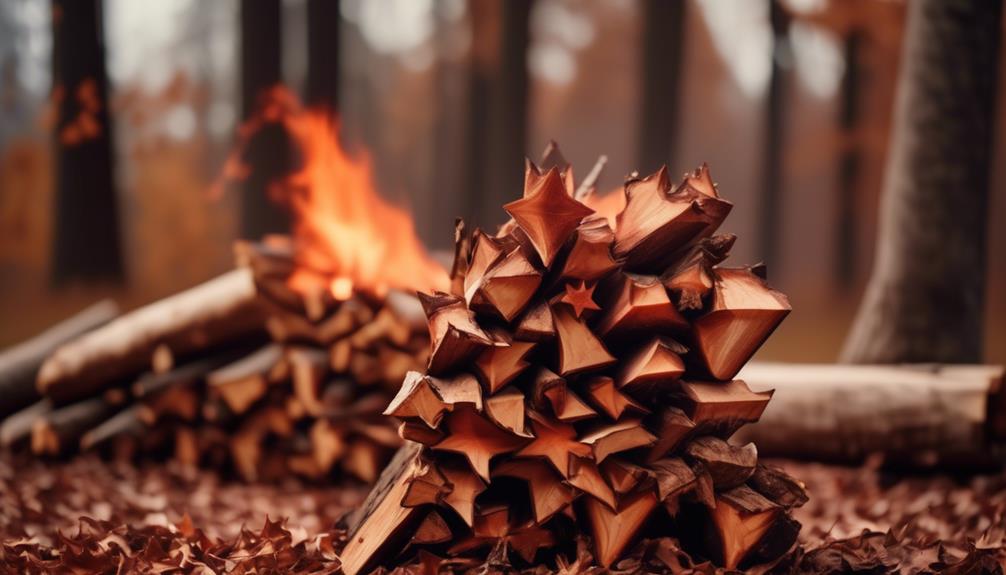
To effectively use sweet gum firewood, consider mixing it with other hardwoods to enhance burning performance and prolong the heat output. Here are some tips for using sweet gum firewood effectively:
- Split sweet gum when it's still green: Green sweet gum wood is easier to split and process. By splitting it early, you can achieve better results and make the wood more manageable for burning.
- Season sweet gum wood for at least one year: Sweet gum firewood needs to be properly seasoned to achieve optimal burning. Store it under a roof or cover to protect it from rot and mold. This will ensure that it burns efficiently and produces more heat.
- Use a hydraulic splitter: Sweet gum wood can be challenging to split and stack. Using a hydraulic splitter can make the process easier and save you time and effort.
Final Verdict: Is Sweet Gum Good Firewood?
Sweet gum firewood may not be the most popular choice due to its difficulty in splitting and stacking, but it can still provide a decent amount of heat for heating a home. While hardwoods like oak and maple are often preferred for firewood, sweet gum can still be a viable option.
It produces approximately 20.6 million BTUs per cord, which is a respectable amount of heat. However, there are some drawbacks to using sweet gum firewood. It burns quickly, lacks good coaling qualities, and produces a significant amount of smoke with an unpleasant odor. Additionally, properly drying out sweet gum can be challenging, taking up to a year to season.
Despite these drawbacks, sweet gum firewood can still be used effectively for heating, but it may require extra effort compared to other hardwoods.
Conclusion
In conclusion, sweet gum can be used as firewood but it has several drawbacks. It's difficult to split and stack, requiring extra effort and energy. Although it produces decent heat, it burns quickly and doesn't create good coaling qualities.
Additionally, it produces a lot of smoke and requires careful attention to safety.
Overall, while sweet gum can be used for heating, many people prefer to avoid it due to the extra work and its less desirable burning characteristics.

